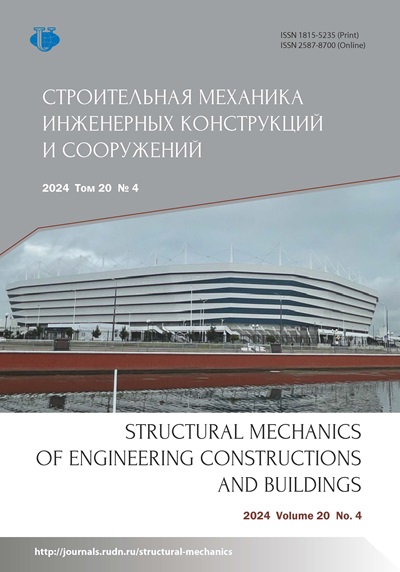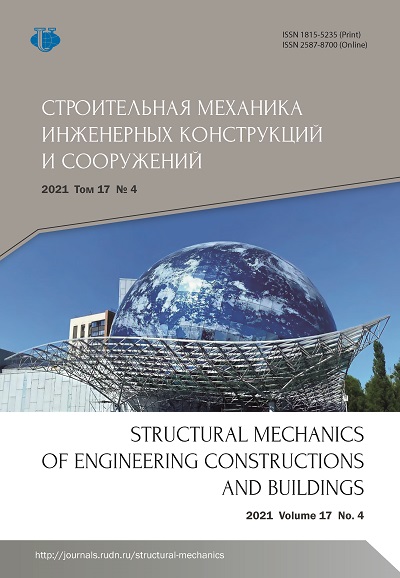Влияние прочности бетона и типа опор на напряженно-деформированное состояние гиперболической параболоидной оболочки для конструкции пешеходного моста
- Авторы: Кахамарка-Сунига Д.1,2, Луна С.1
-
Учреждения:
- Католический университет города Куэнки
- Российский университет дружбы народов
- Выпуск: Том 17, № 4 (2021)
- Страницы: 379-390
- Раздел: Сейсмостойкость сооружений
- URL: https://journals.rudn.ru/structural-mechanics/article/view/29953
- DOI: https://doi.org/10.22363/1815-5235-2021-17-4-379-390
Цитировать
Полный текст
Аннотация
Актуальность. Работа является первой в серии публикаций по выбору аналитической поверхности, подходящей в качестве самонесущей конструкции оболочки для пешеходного моста. Исследуется влияние прочности бетона, положения нагрузки от толпы людей и типа опор на напряженно-деформированное состояние гиперболической параболоидной оболочки (гипар). Цель - определить исходные конструктивные параметры, такие как рекомендуемая прочность бетона и тип опоры, обеспечивающие наилучшее структурное поведение, для последующего выполнения расчета конструкции оболочки для пешеходного моста. Методы. Статический конечно-элементный анализ был проведен для четырех пределов прочности на сжатие бетона (28, 40, 80, 120 МПа), которые соответствуют нормальному, высокому и сверхвысокому сопротивлению бетона, пяти различным схемам расположения нагрузки от толпы и трем различным условиям опирания. Результаты. Двухшарнирные и бесшарнирные модели показывают одинаковые вертикальные перемещения. Для исследуемой толщины оболочки с точки зрения внутренних усилий двухшарнирная модель является более эффективной. Комбинация шарнирных неподвижных опор с прочностью бетона 80 МПа показала лучшее структурное поведение.
Об авторах
Давид Кахамарка-Сунига
Католический университет города Куэнки; Российский университет дружбы народов
Автор, ответственный за переписку.
Email: cajamarca.zuniga@gmail.com
ORCID iD: 0000-0001-8796-4635
доцент департамента строительства, Инженерный факультет; аспирант, ассистент департамента строительства, Инженерная академия
Республика Эквадор, 010101, Куэнка, Av. De las Americas & Humboldt; Российская Федерация, 117198, Москва, ул. Миклухо-Маклая, д. 6Себастиан Луна
Католический университет города Куэнки
Email: selunav07@est.ucacue.edu.ec
ORCID iD: 0000-0003-2431-3960
инженер-строитель, магистр Инженерного факультета
Республика Эквадор, 010101, Куэнка, Av. De las Americas & HumboldtСписок литературы
- Bradshaw R., Campbell D., Gargari M., Mirrniran A., Tripeny P. Special structures: past, present, and future. J. Struct. Eng. 2002;128(6):691-709. http://dx.doi.org/10.1061/(asce)0733-9445(2002)128:6(691)
- Ramm E., Mehlhorn G. On shape finding methods and ultimate load analyses of reinforced concrete shells. Eng. Struct. 1991;13(2):178-198. http://dx.doi.org/10.1016/0141-0296(91)90050-M
- Aleshina O., Cajamarca D., Barbecho J. Numerical comparative analysis of a thin-shell spatial structure for the Candela’s Cosmic Rays Pavilion. Adv. Astronaut. Sci. 2021;174:741-752.
- Pérez-Peraza J. Reminiscences of cosmic ray research in Mexico. Adv. Sp. Res. 2009;44(10):1215-1220. http://dx.doi.org/10.1016/j.asr.2008.11.031
- Minor A. Up-and-down journeys: the making of Latin America’s uniqueness for the study of cosmic rays. Centaurus. 2020;1-23. http://dx.doi.org/10.1111/1600-0498.12335
- Mendoza M. Felix Candela’s first European Project: The John Lewis Warehouse, Stevenage New Town. Archit. Res. Q. 2015;19(2):149-60. http://dx.doi.org/10.1017/S1359135515000251
- Krivoshapko S.N., Hyeng C.A.B., Mamieva I.A. Chronology of erection of the earliest reinforced concrete shells. Int. J. Recent Res. Appl. Stud. 2014;18(2):95-108.
- Krivoshapko S.N., Mamieva I.A. Analytical surfaces in the architecture of buildings, structures and components. Moscow: LIBROKOM Publ.; 2011. (In Russ.)
- Kourkoutas V. Parametric form finding in contemporary architecture Vassilis Kourkoutas. Vienna: Technische Universität Wien; 2007.
- Krivoshapko S.N., Ivanov V.N. Encyclopedia of analytical surfaces Switzerland: Springer International Publishing AG; 2015. http://dx.doi.org/10.1007/978-3-319-11773-7
- Farshad M. Design of hyperbolic paraboloid shells. In: Design and Analysis of Shell Structures. Switzerland: Springer-Science+Business Media, B.V.; 1992. p. 215-247.
- Oliva Quecedo J., Antolin Sanchez P., Cámara Casado A., Goicolea Ruigómez J.M. Finite element model analysis of works authored by Felix Candela. Hormigón y Acero. 2011;(1):61-76.
- Rippmann M. Funicular shell design geometric approaches to form finding and fabrication of discrete funicular structures. PhD Thesis. Zurich; 2016.
- Bischoff M., Ramm E., Irslinger J. Models and finite elements for thin-walled structures. In: Encyclopedia of Computational Mechanics Second Edition. John Wiley & Sons, Ltd.; 2017. http://dx.doi.org/10.1002/9781119176817.ecm2026
- Marmo F., Demartino C., Candela G., Sulpizio C., Briseghella B., Spagnuolo R., et al. On the form of the Musmeci’s bridge over the Basento river. Eng. Struct. 2019;191(May):658-73. http://dx.doi.org/10.1016/j.engstruct.2019.04.069
- Fenu L., Congiu E., Lavorato D., Briseghella B., Marano G.C. Curved footbridges supported by a shell obtained through thrust network analysis. J. Traffic Transp. Eng. (English Ed.) 2019;6(1):65-75. http://dx.doi.org/10.1016/j.jtte.2018.10.007
- Fenu L., Congiu E., Marano G.C., Briseghella B. Shell-supported footbridges. Curved Layer Struct. 2020;7(2): 199-214. http://dx.doi.org/10.1515/cls-2020-0017
- Peiretti H.C., Martín J.R., Delgado J.S., Matadero and invernadero shell footbridges over the Manzanero River in Madrid. Rev. Obras. Publicas. 2011;158(3520):39-50.
- McIntyre J. Outokumpu: building bridges to span over distance and time. Stainless Steel World. 2019;(137):2-3.
- Zeas Guzman K. Los puentes del Centro Histórico de Cuenca. Universidad de Cuenca; 2013.
- Saltik E., Alacam S. Experiments for design and optimization of thin shell structures. ATI 2020: “Smart Buildings, Smart Cities” Proceedings. Izmir: Yaşar University; 2020. p. 76-90.
- American Association of State Highway and Transportation Officials. AASHTO LRFD Bridge Design Specifications. 8th ed. Washington D.C.; 2017 p. 1881.
- ACI 363R-92. State-of-the-art report on high-strength concrete (vol. 92). ACI Committee 363. American Concrete Institute; 1992.
- Razvi S.R., Saatcioglu M. Strength and deformability of confined high-strength concrete columns. ACI Struct. J. 1994;91(6):678-696.
- Sheikh S.A., Shah D.V., Khoury S.S. Confinement of high-strength concrete columns. ACI Struct. J. 1994;91(1):100-111.
- Maten R.N. ter Ultra high performance concrete in large span shell structures. Delft: Delft University of Technology; 2011.
- Perry V., Zakariasen D. First use of ultra-high performance concrete for an innovative train station canopy. Concrete Technology Today - Portland Cement Association. 2004;25(2):1-7.
- Walraven J.C. Designing with ultra high strength concrete: basics, potential and perspectives. In: Schmidt M., Fehling E., Geisenhansluke C. (eds.) Proceedings of the International Symposium on Ultra-High Performance Concrete. Kassel: Die Deutsche Bibliothek; 2004. p. 853-864.
- Ramesh M.N., Teichmann T. Ultra high performance concrete: sustainable and cost effective. B2B Purchase. Mumbai; 2016. Available from https://b2bpurchase.com/ultra-high-performance-concrete-sustainable-and-cost-effective/ (accessed: 02.04.2021).
- Azmee N.M., Shafiq N. Ultra-high performance concrete: from fundamental to applications. Case Stud. Constr. Mater. 2018;9:e00197. http://dx.doi.org/10.1016/j.cscm.2018.e00197
- Sarmiento P.A., Torres B., Ruiz D.M., Alvarado Y.A., Gasch I., Machuca A.F. Cyclic behavior of ultra-high performance fiber reinforced concrete beam-column joint. Struct. Concrete. 2019;20:348-360. http://dx.doi.org/10.1002/suco.201800025
- Shafieifar M., Farzad M., Azizinamini A. Experimental and numerical study on mechanical properties of ultra high performance concrete (UHPC). Constr. Build. Mater. 2017;156:402-411. http://dx.doi.org/10.1016/j.conbuildmat.2017.08.170
- Dingqiang F., Wenjing T., Dandian F., Jiahao C., Rui Y., Kaiquan Z. Development and applications of ultra-high performance concrete in bridge engineering. IOP Conf. Ser. Earth Environ. Sci. 2018;189:22038. http://dx.doi.org/10.1088/1755-1315/189/2/022038
- Bahr O., Schaumann P., Bollen B., Bracke J. Young’s modulus and Poisson’s ratio of concrete at high temperatures: experimental investigations. Mater. Des. 2013;45:421-429. http://dx.doi.org/10.1016/j.matdes.2012.07.070
- Mostofinejad D., Nozhati M D. Prediction of the modulus of elasticity of high strength concrete. Iranian Journal of Science and Technology Transaction B: Engineering. 2005;29(B3):311-321.
- Chen H.J., Yu Y.L., Tang C.W. Mechanical properties of ultra-high performance concrete before and after exposure to high temperatures. Materials (Basel). 2020;13(3):1-17. http://dx.doi.org/10.3390/ma13030770
- Ohmori H., Yamamoto K. Shape optimization of shell and spatial structure for specified stress distribution. Mem. Sch. Eng. Nagoya Univ. Japan. 1998;50(1):1-32.
















